Sphinginae subfamily
Sphingini tribe:
 |
This moth is a very strong flier, and make its way to
southern Arizona and southern California.
|
 |
Ceratomia amyntor
WO,
the Elm Sphinx or Four-horned Sphinx
The upperside of the forewing is brown with dark brown and white markings including a white costal area near the wing base, dark streaks along the veins,
and a white spot in the cell.
Larvae feed on Elm (Ulmus), birch (Betula), basswood (Tilia), and
cherry (Prunus). |
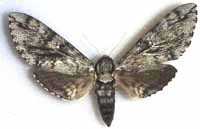 |
The fringes of the upper wings are checkered black and white. The
upperside of the forewing is dark gray with black
bars and dashes and whitish patches. The upperside of the hindwing is
dark brown with pale gray at the base and has
two black transverse lines. rare
|
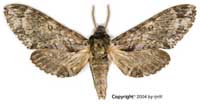 | This small moth flies at dusk. Both the forewing and the hindwing have a dark spot at the anal angle.
The forewing has a dark cell marking with a white center. There is also a dark patch along the inner margin in the basal area.
|
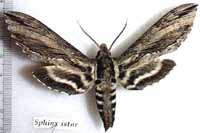 | The upperside of the forewing is dark gray with brown tinges. A
series of narrow dashes runs from the tip to the
cell spots, and a wide black band runs from the middle of the
outer margin to the base of the wing. It flies to the
east and to the south and might be present.
|
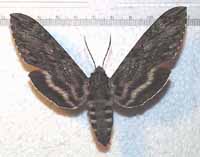 | The upperside of the forewing is dark gray with black and light gray
wavy lines. The upperside of the hindwing is black with a brownish
gray border and two white bands.
|
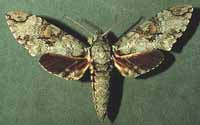 |
The upperside of the forewing is gray to yellowish gray to brown.
The reddish brown patch
just outside the cell and above the dashes is the most distinguishing
character.
|
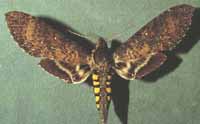 | Manduca occulta can be differentiated from M. sexta
which has 2/3 black, 1/3 white checkering on the
forewing, while occulta has equal amounts of black and white
checkering.
|
 |
Manduca quinquemaculatus
BAMONA,
the Five-spotted Hawkmoth. Abdomen usually has five but sometimes six pairs of yellow bands. Fw upperside s
blurry brown and gray. Hw upperside is banded with brown and white and has two well-separated median zigzag bands.
Fw fringes are grayish, not distinctly spotted with white.
|
 |
The abdomen of the adult moth has three pairs of yellow spots. The upperside of the forewing
is yellowish brown to deep chocolate brown with a dusting of white scales and zigzagged black and white lines.
|
 |
Manduca sexta
WO, the Carolina Sphinx:
Abdomen usually has six pairs of yellow bands, broken across the back; sixth set of markings quite small.
Fw upperside has indistinct black, brown, and white markings.
Hw upperside banded with black and white; has two black zigzag median lines very close together with hardly any white showing between them.
Fw fringes: white-spotted.
|
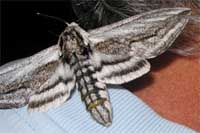 |
The upperside of the forewing has a wide white band along the costa
from base to apex. The remainder of the wing has black and white
bands.
|
 |
Sphinx chersis
BAMONA,
the Northern Ash Sphinx or Great Ash Sphinx: The upperside of the forewing is soft dark gray to blue-gray with a series of black dashes,
one of which reaches the wing tip. The upperside of the hindwing is black with blurry pale gray bands.
|
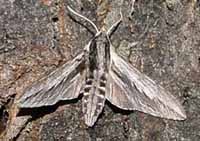 | Sphinx dollii (Wing span: 1 3/4 - 2 1/2 inches (4.5 - 6.3 cm)),
flies in arid brushlands and desert foothills from Nevada and
southern California east through Utah,
Arizona, Colorado, and New Mexico to Oklahoma and Texas.
|
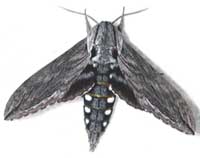 | The upperside of the forewing is pale blue-gray to dark gray with a black dash reaching the wing tip and
a white stripe along the lower outer margin.
The upperside of the hindwing is black with two diffuse white
bands, the upper one being practically non-existent.
|
Smerinthini Tribe:
 |
This one is quite similar to Pachysphinx modesta, with modesta
being smaller and darker.
Moths should be on the wing from June-August.
|
 |
Named for the small eye-spot in the hindwing, this moth has a wide
distribution
and is probably common in your county.
|
 |
Smerinthus cerisyi
BAMONA, the Cerisyi's
Sphinx or One-eyed Sphinx, Larvae feed on poplars and willows.
Flight would be from late May-July as a single brood.
|
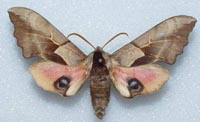 |
Smerinthus saliceti
BAMONA,
the Salicet Sphinx, flies in valleys and along streamsides from Mexico City north
to west Texas, southern Arizona, and extreme southern California.
Larvae feed on poplars and willows.
Flight would be from late April-September, probably as a double brood.
|
Macroglossinae subfamily
Dilophonotini tribe:
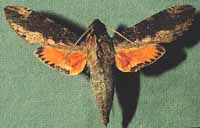 |
The upperside of the abdomen is gray, without black bands, and
the underside does not have black spots. The upperside of the
forewing is dark brown, and may have pale yellow-brown patches
along the inner edge.
|
 |
Erinnyis ello
BAMONA, the Ello Sphinx:
Abdomen: very distinct gray and black bands. Female's fw: pale gray with a few dark dots near the outer margin. Male's
fw upperside: dark gray and brown with black band running from base to tip. In both sexes, hindwing upperside is orange with wide black border.
|
 |
During the night adults nectar at flowers, including bouncing bet
(Saponaria officinalis) and Asystasia gangetica beginning at dusk.
July and August are flight times in the southern states.
|
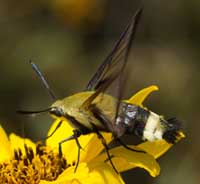 |
Hemaris thetis
WO, the Thetis Clearwing or Bee Hawk Moth.
The moth flies along forest edges and in meadows, gardens and
brushy fields. Day-flying adults nectar at lantana, dwarf bush honeysuckle,
snowberry, orange hawkweed, thistles, lilac, Canada violet, etc.
|
Philampelini tribe:
 |
This moth is officially reported for Pima County.
Eumorpha achemon larvae feed upon Grape (Vitis),
Virginia Creeper (Parthenocissus quinquefolia)
and other vines and ivies (Ampelopsis).
|
Macroglossini tribe:
 |
Hyles lineata
BAMONA,
the White-lined Sphinx:
The forewing upperside is dark olive brown with paler brown along the costa and outer margin, a narrow tan band running from the wing tip to the base, and white streaks along the veins.
The hindwing upperside is black with a reddish pink median band.
|
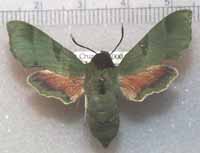 |
The upperside of the forewing is uniform olive green with a darker
median band. The upperside of the hindwing
is red with an olive green border.
|
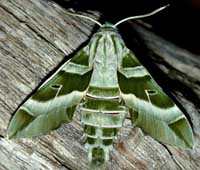 |
Jim Tuttle writes, "P. vega has a very large and dark basal
patch as the FW meets the thorax that is lacking in terlooii.
There are also three prominent longitudinal
stripes on the thorax of vega that are lacking in
terlooii."
|
|
|
